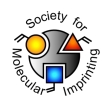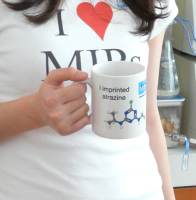
Authors: Wang J, Dai JD, Meng MJ, Song ZL, Pan JM, Yan YS, Li CX
Article Title: Surface molecularly imprinted polymers based on yeast prepared by atom transfer radical emulsion polymerization for selective recognition of ciprofloxacin from aqueous medium.
Publication date: 2014
Journal: Journal of Applied Polymer Science
Volume: 131
Issue: (11)
Page numbers: Article No 40310.
DOI: 10.1002/app.40310
Abstract: To achieve selective recognition of water-soluble ciprofloxacin (CIP), an effective method was developed for the preparation of surface molecularly imprinted polymers based on the yeast particles (yeast@MIPs) via atom transfer radical emulsion polymerization (ATREP). The reactions were carried out in the nontoxic and green emulsion system at room temperature, which was environment friendly with low energy consumption. In this study, the yeast, for the advantages of low cost, easily available source and abundant active groups on the cell wall, was selected as an ideal biological support substrate. The prepared yeast@MIPs was characterized by FT-IR, SEM, TEM, EDS, and elemental analysis techniques. Batch mode adsorption studies were carried out to investigate the specific adsorption equilibrium, kinetics, selective recognition, and reuse ability of yeast@MIPs. The experimental static adsorption data of CIP on to yeast@MIPs were well-described by Langmuir, Freundlich, and pseudo-second-order models. The maximum static adsorption capacity for CIP of yeast@MIPs was 18.48 mg g-1, and the adsorption equilibrium could be reached in 60 min. The selectivity coefficients for CIP relative to enrofloxacin, tetracycline, and sulfadiazine were 1.212, 2.002, and 10.65, which demonstrated CIP of high affinity and selectivity over three competitive antibiotics. In addition, the reusability of the material without obvious deterioration (8.52% loss) in performance was observed at least four repeated cycles. And the yeast@MIPs was used to determine CIP from spiked shrimp samples by HPLC analysis. These results showed that yeast was a well-defined substrate and ATREP was a promising technique for the preparation of surface molecularly imprinted polymers targeting templates. © 2013 Wiley Periodicals, Inc. J. Appl. Polym. Sci. 2014, 131, 40310
Template and target information: ciprofloxacin, CIP
Author keywords: adsorption, molecular recognition, kinetics, separation techniques, emulsion polymerization



Join the Society for Molecular Imprinting

New items RSS feed
Sign-up for e-mail updates:
Choose between receiving an occasional newsletter or more frequent e-mail alerts.
Click here to go to the sign-up page.
Is your name elemental or peptidic? Enter your name and find out by clicking either of the buttons below!
Other products you may like:
 MIPdatabase
MIPdatabase









